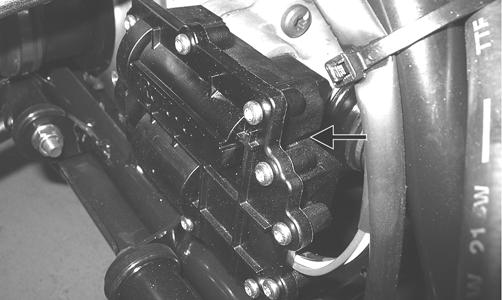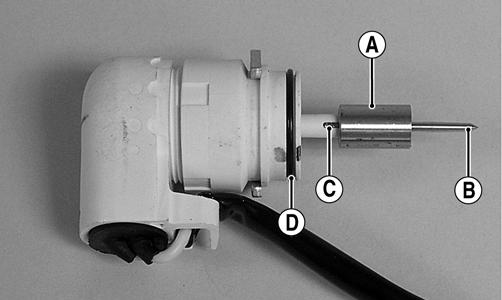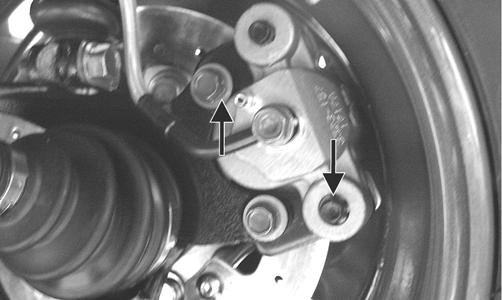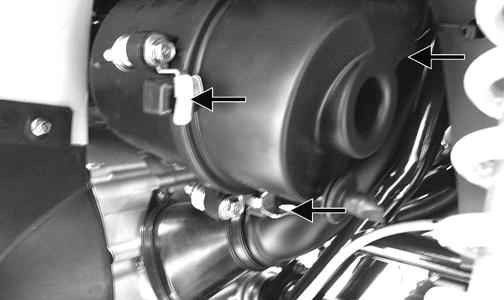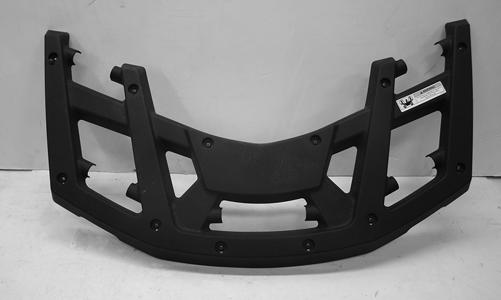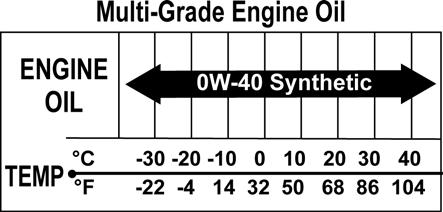
25 minute read
Electrical System
In case of an electrical failure, check fuses, connections (for tightness, corrosion, damage), and/or bulbs.
TESTING ELECTRICAL COMPONENTS All of the electrical tests should be made using the Fluke Model 77 Multimeter. If any other type of meter is used, readings may vary due to internal circuitry. When troubleshooting a specific component, always verify first that the fuse(s) are good, that the bulb(s) are good, that the connections are clean and tight, that the battery is fully charged, and that all appropriate switches are activated. NOTE: For absolute accuracy, all tests should be
made at room temperature of 68° F.
SPECIAL TOOLS A number of special tools must be available to the technician when performing service procedures in this section. Refer to the current Special Tools Catalog for the appropriate tool description. NOTE: When indicated for use, each special tool
will be identified by its specific name, as shown in the chart below, and capitalized.
NOTE: Special tools are available from the Arctic
Cat Service Department.
Description p/n
Fluke Model 77 Multimeter 0644-559 MaxiClips 0744-041
Battery
The battery is located under the seat. After being in service, batteries require regular cleaning and recharging in order to deliver peak performance and maximum service life. The following procedure is recommended for cleaning and maintaining a sealed battery. Always read and follow instructions provided with battery chargers and battery products. NOTE: Refer to all warnings and cautions provided
with the battery or battery maintainer/charger.
Loss of battery charge may be caused by ambient temperature, ignition OFF current draw, corroded terminals, self discharge, frequent start/stops, and short engine run times. Frequent winch usage, snowplowing, extended low RPM operation, short trips, and high amperage accessory usage are also reasons for battery discharge.
Maintenance Charging NOTE: Arctic Cat recommends the use of the
CTEK Multi US 800 or the CTEK Multi US 3300 for battery maintenance charging. Maintenance charging is required on all batteries not used for more than two weeks or as required by battery drain.

800E
1.When charging a battery in the vehicle, be sure the ignition switch is in the OFF position. 2.Clean the battery terminals with a solution of baking soda and water.
NOTE: The sealing strip should NOT be removed
and NO fluid should be added.
3.Be sure the charger and battery are in a well-ventilated area. Be sure the charger is unplugged from the 110-volt electrical outlet.
4.Connect the red terminal lead from the charger to the positive terminal of the battery; then connect the black terminal lead of the charger to the negative terminal of the battery. NOTE: Optional battery charging adapters are
available from your authorized Arctic Cat dealer to connect directly to your vehicle from the recommended chargers to simplify the maintenance charging process. Check with your authorized Arctic Cat dealer for proper installation of these charging adapter connectors.
5.Plug the battery charger into a 110-volt electrical outlet.
6.If using the CTEK Multi US 800, there are no further buttons to push. If using the CTEK Multi US 3300, press the Mode button (A) at the left of the charger until the Maintenance Charge Icon (B) at the bottom illuminates. The Normal Charge Indicator (C) should illuminate on the upper portion of the battery charger.
3300A
NOTE: The maintainer/charger will charge the bat-
tery to 95% capacity at which time the Maintenance Charge Indicator (D) will illuminate and the maintainer/charger will change to pulse/float maintenance. If the battery falls below 12.9 DC volts, the charger will automatically start again at the first step of the charge sequence.
NOTE: Not using a battery charger with the proper
float maintenance will damage the battery if connected over extended periods.
Charging NOTE: Arctic Cat recommends the use of the
CTEK Multi US 800 or the CTEK Multi US 3300 for battery maintenance charging.
1.Be sure the battery and terminals have been cleaned with a baking soda and water solution. NOTE: The sealing strip should NOT be removed
and NO fluid should be added.
2.Be sure the charger and battery are in a well-ventilated area. Be sure the charger is unplugged from the 110-volt electrical outlet.
3.Connect the red terminal lead from the charger to the positive terminal of the battery; then connect the black terminal lead of the charger to the negative terminal of the battery. 4.Plug the charger into a 110-volt electrical outlet. 5.By pushing the Mode button (A) on the left side of the charger, select the Normal Charge Icon (E). The
Normal Charge Indicator (C) should illuminate on the upper left portion of the charger. 6.The battery will charge to 95% of its capacity at which time the Maintenance Charge Indicator (D) will illuminate.
NOTE: For optimal charge and performance, leave
the charger connected to the battery for a minimum 1 hour after the Maintenance Charge Indicator (D) illuminates. If the battery becomes hot to the touch, stop charging. Resume after it has cooled.
7.Once the battery has reached full charge, unplug the charger from the 110-volt electrical outlet. NOTE: If, after charging, the battery does not per-
form to operator expectations, bring the battery to an authorized Arctic Cat dealer for further troubleshooting.
Ignition Switch
The ignition switch harness connects to the switch with a three-pin connector. To access the connector, remove the access panel in front of the handlebar.

XA020
VOLTAGE NOTE: Perform this test on the main harness con-
nector.
1.Set the meter selector to the DC Voltage position. 2.Connect the red meter lead to the red/white wire; then connect the black meter lead to ground. 3.Meter must show battery voltage. NOTE: If the meter shows no battery voltage, trou-
bleshoot the battery or the main wiring harness.
RESISTANCE NOTE: Perform this test on the switch harness
using the following procedure.

KC276A
1.Turn the ignition switch to the ON position. 2.Set the meter selector to the OHMS position. 3.Connect either tester lead to pin B; then connect the other tester lead to pin A. 4.The meter must show less than 1 ohm.
5.Turn the ignition switch to the LIGHTS position.
The meter must show less than 1 ohm.
6.Leaving the tester lead on pin B, connect the other tester lead to pin C. 7.The meter must show less than 1 ohm.
NOTE: If the meter shows more than 1 ohm of resis-
tance, replace the switch.
Ignition Coil
The ignition coil is located under the front access panel. To access the coil, the left side panel must be removed.
RESISTANCE
CAUTION
Always disconnect the battery when performing resistance tests to avoid damaging the multimeter.
NOTE: For these tests, the meter selector should be
set to the OHMS position and the primary wire should be disconnected.
Primary Winding 1.Connect the red tester lead to either terminal; then connect the black tester lead to the other terminal.
2.The meter reading must be within specification. NOTE: Secondary coil resistance checks are not rec-
ommended. An internal diode in the coil prevents accurate secondary resistance measurements.
Spark Plug Cap 1.Connect the red tester lead to one end of the cap; then connect the black tester lead to the other end of the cap.

AR603D
2.The meter reading must be within specification. NOTE: If the meter does not read as specified,
replace the spark plug cap.
Ignition Timing
The ignition timing cannot be adjusted; however, verifying ignition timing can aid in troubleshooting other components. To verify ignition timing, use the following procedure. 1.Attach the Timing Light to the spark plug high tension lead; then remove the timing inspection plug from the left-side crankcase cover.
2.Using the Tachometer, start the engine and run at 1500 RPM; ignition timing should be 10° BTDC. 3.Install the timing inspection plug. If ignition timing cannot be verified, the rotor may be damaged, the key may be sheared, the trigger coil bracket may be bent or damaged, or the CDI unit may be faulty.
Accessory Receptacle/Connector
NOTE: This test procedure is for either the recepta-
cle or the connector.
VOLTAGE 1.Turn the ignition switch to the ON position; then set the meter selector to the DC Voltage position. 2.Connect the red tester lead to the red wire; then connect the black tester lead to ground. 3.The meter must show battery voltage. NOTE: If the meter shows no battery voltage, trou-
bleshoot the battery, fuse, receptacle, connector, or the main wiring harness.
Switches
VOLTAGE (Brakelight) The brakelight switch is located on the top of the auxiliary brake master cylinder and is pressure activated by the hand brake or the auxiliary brake pedal. This switch also activates the start-in-gear (SIG) relay in the power distribution module (PDM). NOTE: The ignition switch must be in the ON posi-
tion.
1.Set the meter selector to the DC Voltage position. 2.Connect the red tester to the orange wire; then connect the black tester lead to ground. 3.The meter must show battery voltage. NOTE: If the meter shows no battery voltage, trou-
bleshoot the battery, fuse, switch, or the main wiring harness.
NOTE: If the meter shows battery voltage, the main
wiring harness is good; proceed to test the switch/component or connector.
RESISTANCE (Brakelight) 1.Remove the spade connectors from the brake switch. 2.Set the meter selector to the OHMS position. 3.Connect the red tester lead to one switch terminal; then connect the black tester lead to the other switch terminal.

KC274
4.When the brake pedal is depressed, the meter must show less than 1 ohm.
NOTE: If the meter shows more than 1 ohm of resis-
tance, replace the switch.
RESISTANCE (HI Beam) The connectors are located under the front access panel next to the PDM. To access the connector, the electrical cover must be removed.
NOTE: These tests should be made on the switch
side of the connector.
1.Set the meter selector to the OHMS position. 2.Connect one tester lead to the brown/black wire; then connect the other tester lead to the lavender wire.
3.With the dimmer switch in the HI position, the meter must show less than 1 ohm.
NOTE: If the meter shows more than 1 ohm of resis-
tance, replace the switch.
RESISTANCE (LO Beam) 1.Connect one tester lead to the brown/black wire; then connect the other tester lead to the white wire.
2.With the dimmer switch in the LO position, the meter must show less than one ohm.
NOTE: If the meter reads greater than one ohm,
replace the switch.
RESISTANCE (Running Lights) 1.Connect one tester lead to the (B) position; then connect the other tester lead to the (C) position.

KC276A
2.With the dimmer switch in the LO position, the meter must show less than one ohm.
RESISTANCE (Emergency Stop) 1.Set the meter selector to the OHMS position. 2.Connect the one lead to the brown/lavender wire; then connect the other tester lead to the black/white wire.
3.With the switch in the OFF position, the meter must show an open circuit. 4.With the switch in the RUN position, the meter must show less than 1 ohm.
NOTE: If the meter shows more than 1 ohm of resis-
tance, replace the switch.
RESISTANCE (Reverse Override) 1.Set the meter selector to the OHMS position. 2.Connect one tester lead to one lavender/red wire; then connect the other tester wire to the green/red wire. The meter must show less than 1 ohm.
3.Depress and hold the reverse override button. The meter must show an open circuit. NOTE: If the meter does not show as specified,
replace the switch.
RESISTANCE (Drive Select)
Component data can be retrieved using the CATT II. Utilize the Sensor Data screen.
The connector is the snap-lock one in front of the steering post. To access the connector, the radiator/electrical access panel cover must be removed. NOTE: Resistance tests should be made with the
connector disconnected and on the switch-side of the connector.
1.Set the meter selector to the OHMS position. 2.Connect the red tester lead to the white/blue wire; then connect the black tester lead to the black wire.
3.With the selector switch in the 2WD position, the meter must show an open circuit. 4.With the selector switch in the 4WD position, the meter must show less than 1 ohm.
NOTE: If the meter does not show as specified,
replace the front drive select switch.
VOLTAGE (Drive Select) NOTE: The battery must be connected when per-
forming voltage tests.
1.Set the meter selector to the DC Voltage position. 2.Connect the black tester lead to the negative battery terminal.
3.Connect the red tester lead to the white/green wire on the harness side of the connector.
4.Turn the ignition switch to the RUN position. 5.The meter must show battery voltage. NOTE: If the meter shows other than specified,
check the harness, connector, main relay, and battery connections.
RESISTANCE (Gear Position) The gear position switch connector is located on the right side of the engine over the V-belt housing.
KC227A
1.Disconnect the gear position switch from the main harness at the connector; then connect the black tester lead to a suitable ground. 2.Select the OHMS position on the tester and connect the red tester lead to the lavender/red wire; then move the shift lever to the R (reverse) position. The meter must read less than 1 ohm.
3.Move the red tester lead and shift lever in turn to the light green/red wire and N (neutral) position, white/black wire and H (high) position, and white/red wire and L (low) position. The meter must read less then 1 ohm in all positions. If not, the shift linkage must be adjusted (see Periodic Maintenance/Tune-Up - Shift Lever) or the switch must be replaced.

Fan Motor
The connector is the black two-prong one located behind the fan assembly along the right-side frame tube. NOTE: To determine if the fan motor is good, con-
nect the red wire from the fan connector to the positive side of a 12 volt DC power supply; then connect the black wire from the fan connector to the negative side. The fan should operate.
NOTE: Fan motor resistance checks are not recom-
mended. Resistance values change with the motor commutator position.
! WARNING
Care should be taken to keep clear of the fan blades.
Lights
VOLTAGE (Headlights) The connectors are the two 4-pin ones snapped onto the front body/rack support. To release the connectors from the frame, press the release tab with a small screwdriver. NOTE: Perform this test on the main harness side of
the connectors. Also, the ignition switch must be in the LIGHTS position.
1.Set the meter selector to the DC Voltage position. 2.Connect the black tester lead to the black wire; then connect the red tester lead to the white wire.
3.With the dimmer switch in the LO position, the meter must show battery voltage. 4.Remove the red tester lead from the white wire and connect to the lavender wire.
5.With the dimmer switch in the HI position, the meter must show battery voltage. NOTE: If battery voltage is not shown in any test,
inspect the fuses, battery, main wiring harness, connectors, or the left handlebar switch.
VOLTAGE (Running Lights) 1.Release the wire connector from the frame; then release and separate the connectors. NOTE: Perform this test on the wiring harness side
of the connectors.
2.Connect the black tester lead of the meter to the black wire; then with the tester in the DC Volts position, connect the red tester lead to the brown/black wire.
3.Turn the ignition switch to the LIGHTS position.
The meter must show battery voltage. NOTE: If the meter does not show voltage, inspect
the LIGHTS fuse, battery connections, or troubleshoot the main wiring harness.
VOLTAGE (Taillights) NOTE: Perform this test on the main harness side of
the connector. Also, the ignition switch should be in the LIGHTS position.
1.Set the meter selector to the DC Voltage position. 2.Connect the black tester lead to the black wire; then connect the red tester lead to the brown/black wire.
3.The meter must show battery voltage. NOTE: If the meter does not show voltage, inspect
fuses, wiring harness, connectors, and switches.
VOLTAGE (Brakelights) NOTE: Perform this test on the main harness side of
the connector. Also, the ignition switch should be in the ON position and the brake (either foot pedal or hand lever) must be applied.
1.Set the meter selector to the DC Voltage position. 2.Connect the black tester lead to the black wire; then connect the red tester lead to the green/yellow wire. 3.The meter must show battery voltage. NOTE: If the meter does not show voltage, inspect
bulb, fuses, wiring harness, connectors, and switches.
Fuse Block/Power Distribution Module
The fuses are located in a power distribution module in front of the steering post. In addition, there is a 30 amp fuse on the starter relay under the seat next to the battery. If there is any type of electrical system failure, always check the fuses first.
NOTE: To remove a fuse, compress the locking tabs
on either side of the fuse case and lift out.

ATV-3085
CAUTION
Always replace a blown fuse with a fuse of the same type and rating.

XA021
NOTE: The ignition switch must be in the LIGHTS
position.
1.Remove all fuses from the distribution module.
2.Set the meter selector to the DC Voltage position. 3.Connect the black tester lead to ground. 4.Using the red tester lead, contact each end of the fuse holder connector terminals individually. 5.The meter must show battery voltage from one side of the connector terminal ends. NOTE: Battery voltage will be indicated from only
one side of the fuse holder connector terminal; the other side will show no voltage.
NOTE: When testing the HI fuse holder, the head-
light dimmer switch must be in the HI position; when testing the LIGHTS fuse holder, the headlight dimmer switch can be in either position.
NOTE: If the meter shows no battery voltage, trou-
bleshoot the battery, switches, distribution module, or the main wiring harness.
FUSES 1.Set the meter selector to the OHMS position. 2.Connect the red tester lead to one spade end of the fuse; then connect the black tester lead to the other spade end. 3.The meter must show less than 1 ohm resistance. If the meter reads open, replace the fuse. NOTE: Make sure the fuses are returned to their
proper position according to amperage. Refer to the fuse block cover for fuse placement.
RELAYS The relays are identical plug-in type located on the power distribution module. Relay function can be checked by switching relay positions. The relays are interchangeable. NOTE: The module and wiring harness are not a
serviceable component and must be replaced as an assembly.
Sensors/Components
SPEED SENSOR 1.Set the meter selector to the DC Voltage position. 2.With appropriate needle adapters on the meter leads, connect the red tester lead to the brown/blue wire (V); then connect the black tester lead to the black wire (G).

KC248A
3.Turn the ignition switch to the ON position. 4.The meter will typically show battery voltage. 5.Leave the black tester lead connected; then connect the red tester lead to the violet wire (S).
6.Slowly move the ATV forward or backward; the meter must show near 0 and battery voltage alternately. NOTE: If the sensor tests are within specifications,
the speedometer must be replaced (see Steering/Body/Controls).
To replace a speed sensor, use the following procedure. 1.Disconnect the three-wire connector from the speed sensor; then remove the cap screw securing the sensor to the sensor housing. 2.Remove the sensor from the sensor housing accounting for an O-ring. 3.Install the new speed sensor into the housing with new O-ring lightly coated with multi-purpose grease; then secure the sensor with the cap screw (threads coated with blue Loctite #242). Tighten securely.

CD071
OIL TEMPERATURE AND COOLING FAN 1.Connect the meter leads (selector in the OHMS position) to the switch contacts. 2.Suspend the switch and a thermometer in a container of cooking oil; then heat the oil. NOTE: Neither the switch nor the thermometer
should be allowed to touch the bottom of the container or inaccurate readings will occur. Use wire holders to suspend switch and thermometer.
! WARNING
Wear insulated gloves and safety glasses. Heated oil can cause severe burns.
3.On the oil temperature switch when the oil temperature reaches 160° C (320° F), the meter should read a closed circuit.
4.On the oil temperature switch, allow the oil to cool, and when the temperature is at (or just before) a temperature of 140° C (284° F), the meter should read an open circuit. 5.On the cooling fan switch when the temperature reaches 120° C (248° F), the meter should read a closed circuit.
6.On the cooling fan switch, allow the oil to cool, and when the temperature is at (or just before) a temperature of 110° C (230° F), the meter should read an open circuit. 7.If the readings are not as indicated, the switch must be replaced. 8.Apply thread tape to the threads of the switch; then install the switch and tighten securely. 9.Connect the switch leads.
RPM Limiter
NOTE: The ATV is equipped with a CDI unit that
retards ignition timing when maximum RPM is approached. When the RPM limiter is activated, it could be misinterpreted as a high-speed misfire.
Stator Coil
VOLTAGE (Charging Coil - No Load) The connector is the black three-pin one on the right side of the engine just above the starter motor. NOTE: Test the engine-side of the connector. 1.Set the meter selector to the AC Voltage position. 2.Test between the three yellow wires for a total of three tests.
3.With the engine running at the specified RPM, all wire tests must show 60 AC volts.
CAUTION
Do not run the engine at high RPM for more than 10 seconds.
RESISTANCE (Charging Coil) 1.Set the meter selector to OHMS position. 2.Test between the three yellow wires for a total of three tests.
3.The meter reading must be within specification. NOTE: If both charging coil tests failed, check all
connections, etc., and test again. If no voltage is present, replace the stator assembly.
RESISTANCE (Trigger Coil) 1.Disconnect the gray four-pin connector on the right side of the engine just above the starter motor. 2.Set the meter selector to the OHMS position. 3.Connect the red tester lead to the green/white wire; then connect the black tester lead to the blue/yellow wire. The meter reading must be within specification.
Regulator/Rectifier
The regulator/rectifier is located under the front rack and front fenders above the oil cooler.
TESTING 1.Start engine and warm up to normal operating temperatures; then connect a multimeter to the battery as follows.
2.Select the DC Voltage position; then connect the red tester lead to the positive battery post and the black tester lead to the negative battery post. 3.Start the engine and slowly increase RPM. The voltage should increase with the engine RPM to a maximum of 15.5 DC volts.
CAUTION
Do not run the engine at high RPM for more than 10 seconds.
NOTE: If voltage rises above 15.5 DC volts, the reg-
ulator is faulty or a battery connection is loose or corroded. Clean and tighten battery connections or replace the regulator/rectifier. If voltage does not rise, check Voltage (Charging Coil - No Load) in this section. If charging coil voltage is normal, replace the regulator/rectifier.
Starter Motor
NOTE: The starter motor is a non-serviceable com-
ponent. If the following test does not result as specified, the starter motor must be replaced.
TESTING VOLTAGE Perform this test on the starter motor positive terminal. To access the terminal, slide the boot away. NOTE: The ignition switch must be in the ON posi-
tion, the emergency stop switch in the RUN position, and the shift lever in the NEUTRAL position.
1.Set the meter selector to the DC Voltage position. 2.Connect the red tester lead to the starter terminal; then connect the black tester lead to ground. 3.With the starter button depressed, the meter must show approximately 10.0 DC volts and the starter motor should operate.

XA022
NOTE: If the meter showed correct voltage but the
starter did not operate or operated slowly, the starter motor is defective.
NOTE: If the meter showed no voltage, inspect ground connections, starter motor lead, battery voltage (at the battery), starter relay, or the neutral start relay.
REMOVING 1.Disconnect the battery cables (negative cable first); then remove the right side panel and intake tube.
2.Remove the nut securing the positive cable to the starter; then remove the cable from the starter. 3.Fasten the intake tube with the clamps; then install the right side panel. 4.Remove the two cap screws securing the starter to the crankcase; then remove the starter. Account for an O-ring. CAUTION
Always disconnect the negative battery cable from the battery first; then disconnect the positive cable.
INSTALLING 1.Apply a small amount of grease to the O-ring seal on the starter; then install the starter into the crankcase. Secure with two cap screws making sure the engine ground is secured by the rear cap screws. Tighten to 8 ft-lb.

KC201A
2.Secure the positive cable to the starter with the nut.
Tighten to 8 ft-lb. 3.Secure the intake tube with the clamps; then install the right side panel. 4.Connect the battery.
Starter Relay
1.Remove the seat; then using the multimeter set to the
DC Voltage position, check the relay as follows. 2.Connect the red tester lead to the positive battery terminal; then connect the black tester lead to the starter cable connection on the starter relay. The meter must show battery voltage. NOTE: Make sure that the ignition switch is in the
ON position, transmission in neutral, brake lock released, and the emergency stop switch in the RUN position.
3.Depress the starter button while observing the multimeter. The multimeter should drop to 0 volts, a
“click” should be heard from the relay, and the starter motor should run. NOTE: If a “click” is heard and any voltage is indi-
cated by the multimeter, replace the starter relay. If no “click” is heard and the multimeter continues to indicate battery voltage, test the neutral start relay.
CDI Unit
The CDI is located on the electrical tray in front of the steering post.
NOTE: The CDI unit is not a serviceable compo-
nent. If the unit is defective, it must be replaced.
The CDI is rarely the cause for electrical problems; however, if the CDI is suspected, substitute another CDI unit to verify the suspected one is defective. NOTE: Prior to replacing the CDI unit to assure the
CDI unit is defective, it is advisable to perform a CDI peak voltage test (see Ignition Coil in this section) and/or perform a continuity test of the wiring harness from the CDI connector to the CDI unit.
Troubleshooting
Problem: Spark absent or weak Condition Remedy
1. Ignition coil defective 2. Spark plug defective 3. Alternator defective 4. CDI unit defective 5. Pick-up coil defective 1. Replace ignition coil 2. Replace plug 3. Replace stator coil 4. Replace CDI unit 5. Replace stator coil
Problem: Spark plug fouled with carbon Condition Remedy
1. Gasoline incorrect 2. Air cleaner element dirty 3. Spark plug incorrect (too cold) 4. Valve seals cracked - missing 5. Oil rings worn - broken 6. Mixture too rich 7. Idling RPM too high 1. Change to correct gasoline 2. Clean element 3. Replace plug 4. Replace seals 5. Replace rings 6. Replace jets with correct size 7. Adjust carburetor
Problem: Spark plug electrodes overheat or burn Condition Remedy
1. Spark plug incorrect (too hot) 2. Engine overheats 3. Spark plug loose 4. Mixture too lean 1. Replace plug 2. Service oil filter 3. Tighten plug 4. Replace jets with correct size
Problem: Alternator does not charge Condition Remedy
1. Stator wires/connections shorted - loose - open 2. Stator coils shorted - grounded - open 3. Regulator/rectifier defective
1. Repair - replace - tighten stator wires 2. Replace stator coils 3. Replace regulator/rectifier
Problem: Alternator charges, but charging rate is below the specification Condition Remedy
1. Stator wires shorted - open - loose (at terminals) 2. Stator coils grounded - open 3. Regulator/rectifier defective 4. Battery defective 5. Electrolyte low 1. Repair - tighten Stator wires 2. Replace stator coils 3. Replace regulator/rectifier 4. Replace battery 5. Add distilled water
Problem: Alternator overcharges Condition Remedy
1. Battery shorted 2. Regulator/rectifier damaged - defective 3. Regulator/rectifier poorly grounded 1. Replace battery 2. Replace regulator/rectifier 3. Clean - tighten ground connection
Problem: Charging unstable Condition Remedy
1. Stator wire intermittently shorting 2. Alternator internally shorted 3. Regulator/rectifier defective 1. Replace stator wire 2. Replace stator coil 3. Replace regulator/rectifier
Problem: Starter button inoperative Condition Remedy
1. Battery charge low 2. Switch contacts defective 3. Starter motor defective 4. Starter relay defective 5. Emergency stop - ignition switch off 6. Wiring connections loose - disconnected
1. Charge - replace battery 2. Replace switch 3. Replace starter motor 4. Replace relay 5. Turn on switches 6. Connect - tighten - repair connections
Problem: Battery “sulfation” (Acidic white powdery substance or spots on surfaces of cell plates) Condition Remedy
1. Charging rate too low - too high 2. Battery run-down - damaged 3. Electrolyte contaminated 4. Battery electrolyte insufficient 5. Specific gravity too low 1. Repair charging system 2. Replace battery 3. Replace battery 4. Keep electrolyte to prescribed level 5. Charge battery - add distilled water
Problem: Battery discharges too rapidly Condition Remedy
1. Electrolyte contaminated 2. Charging system not charging 3. Battery overcharged - damaged 4. Battery short-circuited 5. Specific gravity too low 1. Replace battery 2. Check alternator - regulator/rectifier - circuit connections 3. Replace battery - correct charging system 4. Replace battery 5. Charge battery - add distilled water

